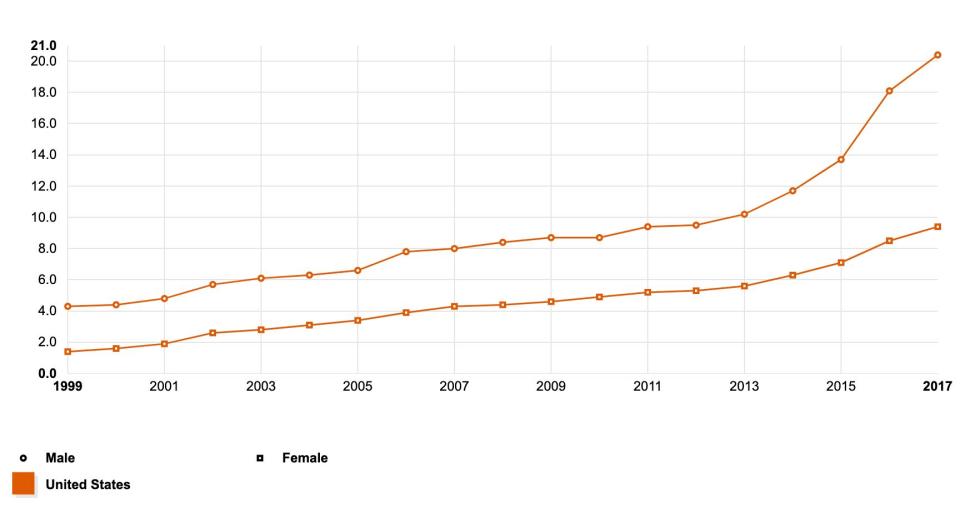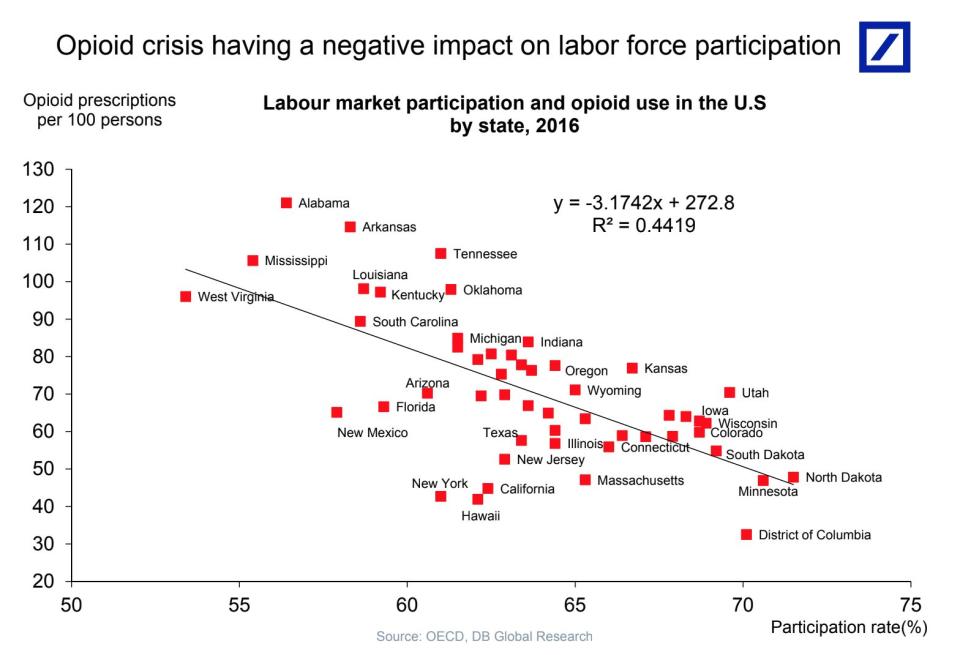A 'really important piece of evidence' shows how opioids keep Americans out of the workforce
The opioid crisis has affected the U.S. in myriad ways, including through drops in life expectancy, distrust in the number of prescriptions from physicians, and now labor force participation.
A recent study by the Cleveland Fed took a close look at the national average opioid prescription rates between 2000 and 2016 to if and how it contributed to decreases in labor force participation rate.
“What we see is substantial effects for prime-age men and women,” Mark Schweitzer, senior vice president at the Cleveland Fed, told Yahoo Finance. “When I think about what stands out within the results, I go to the fact that we do see a problem, particularly for prime-age men with less than a college education. They have the largest effects that we’re seeing in our analysis.”
An expert from the RAND Drug Policy Center, who was not involved in the study, called the data “one really important piece of evidence.”

‘Men are abusing opioids at twice the rate of women’
The study concluded that “prescription opioids can account for 44% of the realized national decrease in men's labor force participation between 2001 and 2015” and a 17% decline for prime age women.
And while the data-gathering methods didn’t enable the researchers to infer why men are affected more than women, Schweitzer said, “what we do see is the evidence coming from national data on abuse rates of opioids shows that men are abusing opioids at twice the rate of women.”
In 1999, the number of male opioid overdose deaths was at a rate of 4.3 per 100,000 individuals, compared to 1.4 of females. That number shot up to 20.4 per 100,000 among males in 2017, compared to 9.4 of females.

“I don’t know why men are more likely to abuse opioids,” Schweitzer said. “But it definitely stands out that men with less of an education continue to have relatively high effects on their labor force participation.”
Schweitzer stressed the difficulty of separating opioid abuse from other factors that could interfere with labor force participation, such as recessions.
“We’re trying to analyze how many people are working, and what’s their response to being in a county with a high level of opioids,” Schweitzer said. “But we’re doing it in a period from 2006 to 2016. Of course, there was a recession in this period, and that recession matters a lot when you think about the employment outcomes of people. So, you want to be controlling for that.”
‘It’s just really difficult to tease out’
The study noted that “geographic regions can also have persistently different labor market outcomes that are not just a function of business cycle shocks.”
For examples, there are places like in the Appalachians that “have experienced both persistently weak labor markets and high levels of opioid prescriptions and deaths.” So correlation does not necessarily equal causation, and it’s not clear what came first: persistent opioid usage or weak labor markets.

The Cleveland Fed study does “a good job trying to account for all the other possible things that could also be correlated with opioid prescribing and economic conditions at the same time,” David Powell, a senior economist at the RAND Drug Policy Center, told Yahoo Finance. “It’s just really difficult to tease out, so this is one really important piece of evidence.”
The study tracks with a 2018 chart from Deutsche Bank’s Torsten Slok showing that the opioid crisis appeared to be contributing to decreased labor force participation, especially in certain U.S. states.
West Virginia, Mississippi, Alabama, and Arkansas saw a particularly high correlation between opioid prescriptions and lack of labor market participation, as indicated by this chart:

And at the end of the day, no matter how much opioid prescription rates affect labor force participation, working age persons staying out of the workforce is a negative for the economy.
“There are real fundamental determinants of how large our economy can be,” Schweitzer said. “You want your labor force participation rate to be as high as you can have it, and we want everyone who can be participating to be participating.”
Adriana is an associate editor for Yahoo Finance. Follow her on Twitter @adrianambells.
READ MORE:
FDA opioids adviser: 'One thing is clear' about the ongoing crisis
'It didn't happen overnight': How the U.S. opioid crisis got so bad
Chart: The U.S. opioid crisis is holding back certain states
Follow Yahoo Finance on Twitter, Facebook, Instagram, Flipboard, LinkedIn, YouTube, and reddit.
